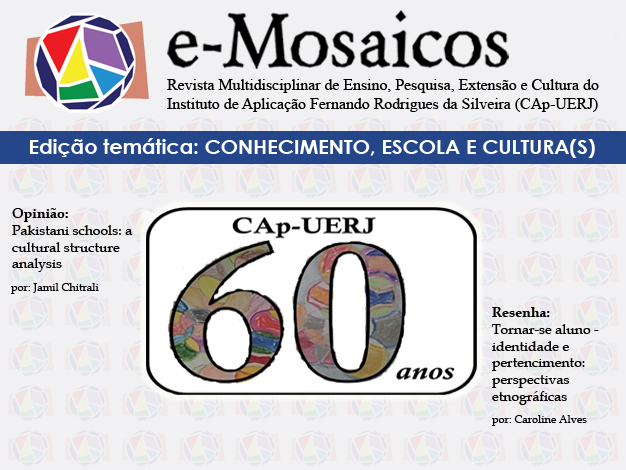PAKISTANI SCHOOLS: A CULTURAL STRUCTURE ANALYSIS
DOI:
https://doi.org/10.12957/e-mosaicos.2017.28528Resumo
DOI: 10.12957/e-mosaicos.2017.28528
The aim of this article is to present the need to consider some important facts to deal with the problem of Education, Gender, Radicalization, Documentation of Economy and Democratization of institutions through a program of Education Reforms in Pakistan as a one package. We need to consider out of box, research based on native solutions. One of the more important questions to analyze is the fact that in Pakistan, school system is divided into three tiers. Primary schools; enroll and retain students from grade 1 through grade 5, followed by enrolment in middle schools; (grade 6th to grade 8th) through to, high schools; (grade 9th to grade 10th). In addition to this, there are higher secondary schools, replacing high schools in most cases, which offer enrolment from grade 9th to grade 12th. This last tier is not considered as the fourth one because there is no school exists in the country which offers only grade 9 to 12 educations but this is mostly an attachment or part of school or college to have students beyond grade 10. The concept was to extend schooling to twelve grades from 10 and colleges only to deal with four years bachelor program that others call undergrad. With densely populated schools and poor infrastructure available you cannot just put in more 25 million, nor can you let them wait till the schools are build and teachers are employed, let the quality of education, poverty, lack of interest from parents, training of teachers compromised.
Downloads
Downloads
Publicado
Como Citar
Edição
Seção
Licença

A revista e-Mosaicos Revista Multidisciplinar de Ensino, Extensão e Cultura do Instituto de Aplicação Fernando Rodrigues da Silveira (CAp-UERJ) está licenciada com uma Licença Creative Commons - Atribuição-NãoComercial 4.0 Internacional.
Os direitos autorais de todos os trabalhos publicados na revista pertencem ao(s) seu(s) autor(es) e coautor(es), com o direito de primeira publicação cedido à e-Mosaicos.
Os artigos publicados são de acesso público, de uso gratuito, com atribuição de autoria obrigatória, para aplicações de finalidade educacional e não-comercial, de acordo com o modelo de licenciamento Creative Commons adotado pela revista.
As ideias e opiniões expressas no artigo são de exclusiva responsabilidade do autor, não refletindo, necessariamente, as opiniões da revista.
Após a primeira publicação, o autor tem autorização para assumir contratos adicionais, independentes da revista, para a divulgação do trabalho por outros meios (ex.: publicar em repositório institucional ou como capítulo de livro), desde que feita a citação completa da mesma autoria e da publicação original.
O autor de um artigo já publicado tem permissão e é estimulado a distribuir o seu trabalho online, sempre com as devidas citações da primeira edição.


